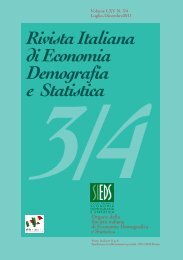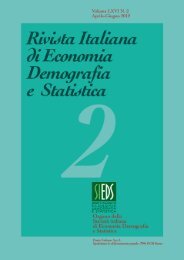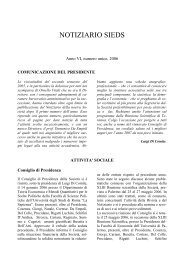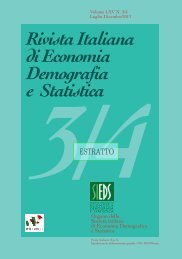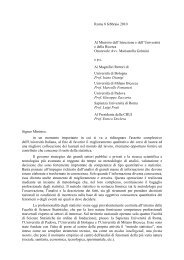rivista italiana di economia demografia e statistica - Sieds
rivista italiana di economia demografia e statistica - Sieds
rivista italiana di economia demografia e statistica - Sieds
You also want an ePaper? Increase the reach of your titles
YUMPU automatically turns print PDFs into web optimized ePapers that Google loves.
Rivista Italiana <strong>di</strong> Economia Demografia e Statistica 145<br />
Patil G. P., Taillie C. 2004. Upper level set scan statistic for detecting arbitrarily shaped<br />
hotspots. Environmental and Ecological Statistics, n. 11, pagg. 183-197.<br />
Takahashi K., Yokoyama T., Tango T. 2004. FleXScan: Software for the flexible spatial<br />
scan statistic. National Institute of Public Health, Japan.<br />
SUMMARY<br />
Hot spot of poverty: some comparison among several urban areas<br />
Poverty clusters have high concentration of poor people, but that does not mean<br />
that everyone living in them is poor. While poverty is widely accepted to be an<br />
inherently multi-<strong>di</strong>mensional concept, it has proved very <strong>di</strong>fficult to develop<br />
measures that both capture this multi<strong>di</strong>mensionality and make comparisons over<br />
time and space easy: for example, in poverty areas earnings are lower and<br />
unemployment is higher, as well as adverse housing and neighbourhood con<strong>di</strong>tions<br />
are more frequent. The fuzzy set approach to multi<strong>di</strong>mensional poverty<br />
measurement is enjoying increasing popularity A <strong>di</strong>fferent but strongly related<br />
issue concerns the geoinformatic surveillance for poverty hot-spot detection: hotspot<br />
means a local “outbreak” of persistent poverty typologies. Circle-based<br />
spatial-scan statistics (Kulldorff, 1997, Patil and Taille, 2004, Aldstat and Getis,<br />
2006) is a popular approach, and is now widely used by many governments and<br />
academic researchers.<br />
In this paper we define a [0-1]-valued fuzzy poverty measure for the census<br />
sections in the urban area of Bologna, Cagliari and Naples, in Italy: data were<br />
drawn from the 2001 Italian General Census. The upper level set scan statistics<br />
applied to a continuous response variable (Patil et al., 2006, Patil et al., 2007) was<br />
used to successfully identifying poverty clusters. The implications and possibilities<br />
for applications to <strong>di</strong>gital governance are also <strong>di</strong>scussed.<br />
___________________________<br />
Silvestro MONTRONE, Professore Or<strong>di</strong>nario <strong>di</strong> Statistica, Facoltà <strong>di</strong> Economia,<br />
Università <strong>di</strong> Bari.<br />
Massimo BILANCIA, Professore Associato <strong>di</strong> Statistica, Facoltà <strong>di</strong> Economia,<br />
Università <strong>di</strong> Bari.<br />
Paola PERCHINUNNO, Ricercatore <strong>di</strong> Statistica, Facoltà <strong>di</strong> Economia, Università <strong>di</strong><br />
Bari.



